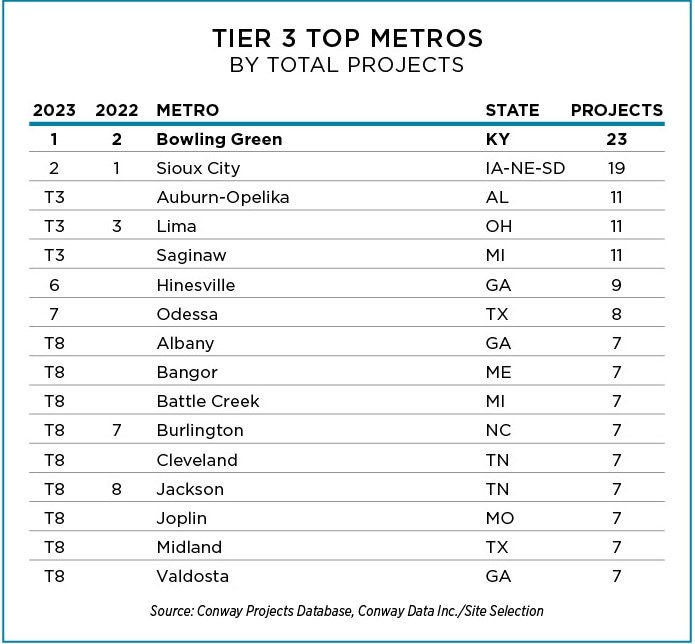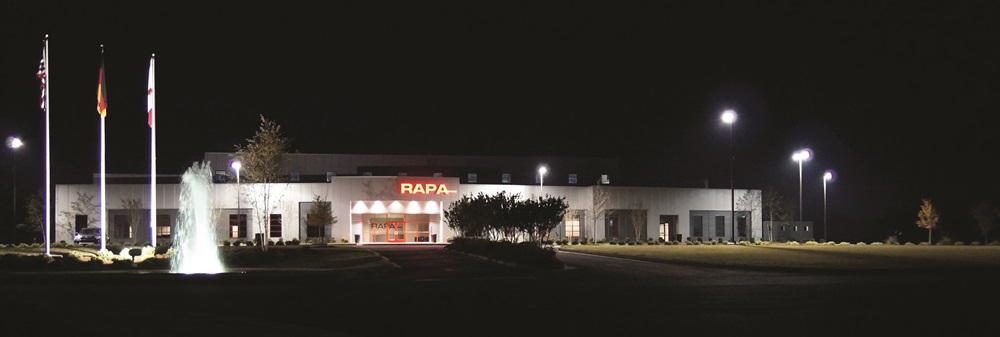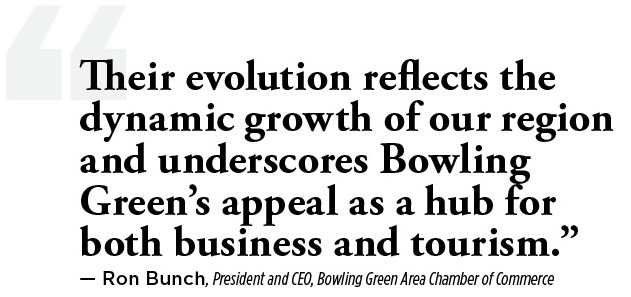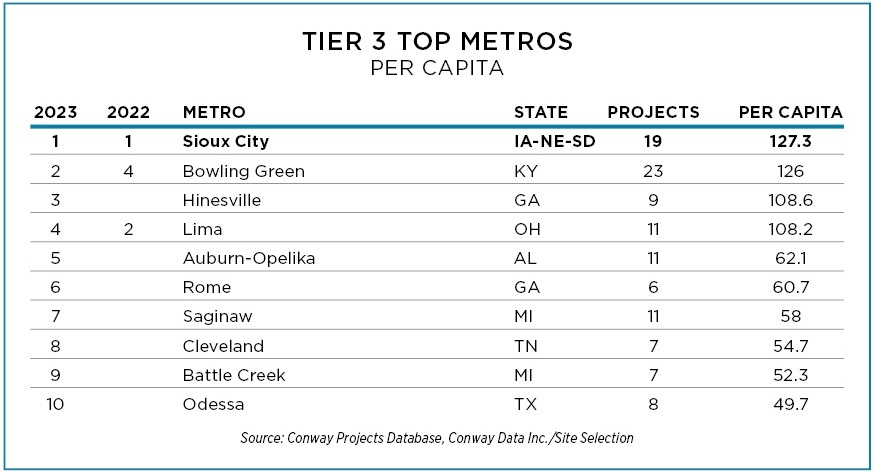Gaze across the profiles of America’s 160 Tier-3 metro areas and you see straight into their insides. They know what they’re about, and there’s not a lot of static between what you see and what you get.
For these communities with populations of over 50,000 but under 200,000, it’s a matter of building on industrial strengths and making sure those strengths are on display near an Interstate or four-lane highway, preferably with a community/technical college or regional university in spitting distance and a quaint downtown with enough dining variety to please the same international clientele that call on metros of other sizes.

Photo courtesy of Bowling Green Chamber of Commerce
Bowling Green, Kentucky, checks all the boxes. Which is why it’s this year’s No. 1 metro area by projects with 23, just above the 19 projects in perennial leader Sioux City, Iowa-Nebraska-South Dakota. In a three-way tie for third we find Auburn-Opelika, Alabama; Lima, Ohio; and Saginaw, Michigan, with 11 projects apiece. Hinesville, Georgia, located just south of the Savannah area, comes in at No. 6 with nine projects, followed by the Permian Basin dynamo of Odessa, Texas, at No. 7 with eight projects. Then it’s a virtual melee at No. 8 with nine communities tied at seven projects apiece, including two in Tennessee (Jackson and Cleveland) and two in Georgia (Albany and Valdosta).
 The sun sets over Veteran’s Memorial Bridge and the Missouri River in Sioux City.
The sun sets over Veteran’s Memorial Bridge and the Missouri River in Sioux City.
Photo by Matthew Howieson: Getty Images
Milken Institute’s 2024 Best-Performing Cities Index finds Bowling Green No. 39 among more than 200 small communities it analyzed, but it represents an upward leap of 64 positions from No. 103 last year. Similarly, Siouxland jumped by 77 spots since last year to be ranked No. 77 this year. Auburn-Opelika, at No. 14, moved up 26 spots.
Since 2021, the Bowling Green Chamber of Commerce has announced 5,679 new jobs with total capital investment of nearly $3 billion and a total economic impact of $20.9 billion over the next decade, the organization announced with the release of an update report in early February. Among other stats, the area has added more than 11,200 residents.
Add a new Canadian employer to the roster of international companies sprinkled across the Bowling Green community along I-65 an hour north of Nashville. In August of last year, Vaughan, Ontario-based plastic products manufacturer Gracious Living acquired an active 160,000-sq.-ft. injection molding operation in Morgantown whose molding machines serve the state’s vibrant automotive sector.

“Plans are currently in development to upgrade the existing facility and add additional equipment to support automotive growth, diversifying Gracious Living’s product offering through branded and custom engineered products within the consumer, construction, recreational and appliance industries,” the company announced in a press release. “Once at full capacity, Gracious Living expects to add 150 full-time jobs further contributing to the economic development of the region. Kentucky is an ideal location for the company’s U.S. expansion, further supporting Gracious Living’s current customers while solidifying new opportunities for future U.S. growth.”
“This acquisition is a key component of our U.S. expansion strategy and product diversifications plans,” said Gracious Living Founder and Executive Vice President Vito Galloro. “We are pleased to bring our brand to Morgantown and proud to support this vibrant community with new economic development, full-time jobs and a robust innovation agenda.”
How About Some Ice Cream With That Bacon?
A similar note was sounded by Donnie King, president and CEO of Tyson Foods, as the Inter-Modal Transportation Authority (ITA) welcomed the official opening in January of a $355 million, 400,000-sq.-ft. new food production facility at the Kentucky Transpark that will create nearly 450 jobs. “Our Bowling Green plant is a testament to Tyson Foods’ commitment to accelerating long-term growth aligned with consumer trends,” King said.
“We chose Bowling Green, Kentucky, to support our growth strategy for Prepared Foods, need for a skilled workforce, and desire to partner with a growing and supportive local community.”

The plant, which broke ground in February 2022, will produce Jimmy Dean® brand and Wright® Brand bacon retail products as well as bacon for foodservice. The plant is expected to output over 2 million pounds of raw bacon products each week, meeting escalating demand in retail and foodservice. The grand opening announcement said Tyson has partnered with Southcentral Kentucky Community and Technical College (SKYCTC) to establish training programs.
Among the niche manufacturing operations associated with both Bowling Green and Siouxland is quality ice cream. In Sioux City’s case, the company is located in Le Mars, Iowa, where Wells Enterprises, now part of the Ferrero Group, churns out Blue Bunny Ice Cream and the Original Bomb Pops in addition to an array of other frozen treats that make Le Mars the “ice cream capital of the world.”
In Bowling Green, the legendary ice cream maker is Chaney’s Dairy Barn, which has grown from producing 3,000 gallons a year when it opened in 2003 to more than 25,000 gallons a year today and a goal of reaching 30,000 gallons this year. Helping it serve all that frozen goodness will be a $2.6 million, 10-job expansion that includes a new 50-seat dining room and other amenities for both locals and the area’s growing stream of tourists who used to come through just for the Corvette Museum but now have more options.
“After 20 years in business, we are excited and proud to expand and offer enhanced customer service with new ice cream service lines and be able to allow our customers to watch our ice cream get produced in front of them,” said owner Carl Chaney in a recent press release. Among other highlights for the company over the past year, Guy Fieri stopped by and featured Chaney’s Dairy Barn in the first episode of season two of “Guy’s All-American Road Trip.”

“Their evolution reflects the dynamic growth of our region,” said Ron Bunch, president and CEO of the Bowling Green Area Chamber of Commerce, “and underscores Bowling Green’s appeal as a hub for both business and tourism.”
Siouxland Tops Per Capita Rankings
In this year’s per-capita contest, perennial leaders in the tri-state Siouxland region encompassing Sioux City, Sergeant Bluff and Lemars, Iowa; South Sioux City and Dakota City, Nebraska; and North Sioux City and Dakota Dunes, South Dakota, find themselves king of the hill once more, outdueling Bowling Green for the per-capita crown.
Hinesville, Lima and Auburn-Opelika round out the top five. The only community on this list that isn’t on the project totals list is No. 6 Rome, Georgia, just ahead of Saginaw, Cleveland (Tennessee), Battle Creek and Odessa.

In Siouxland the projects are remarkably distributed almost equitably across the three states, which Chris McGowan, president of the Siouxland Chamber of Commerce and The Siouxland Initiative (TSI), likes to drive visitors through in order to demonstrate how quickly one can be in all three. The advantages and clustering one finds at any juncture of city or county boundaries is only accentuated when there are three states and the Missouri River involved. Prospects have choices, and they are choosing the region.

Masco Corporation’s Delta Faucet, founded 70 years ago this year, continues to invest in Bowling Green, choosing last year to commit $5 million toward an expansion that will create 131 jobs.
Photo courtesy of Delta Faucet
Among the 2023 qualifying projects are a $14 million, 70-job investment from GWD Ltd. and a $3 million, 15-job investment by Scratch and Peck Feeds in South Sioux City; a $27 million project from Perdue Foods and a $4 million project from Sioux City Distillery in Sioux City proper; and projects from Consumers Supply Distributing and Farmers Cooperative Society in the Union County, South Dakota portion of the tri-state.
